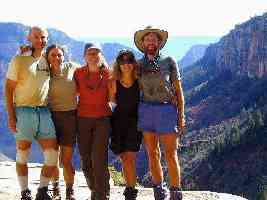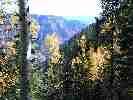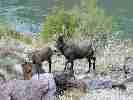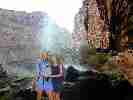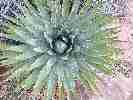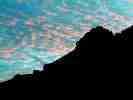
|
|---|
Ribbon Falls
(Click the image for a full-size view)
|
|---|
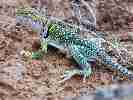
|
|---|
Colared Lizard
(Click the image for a full-size view)
|
|---|
|
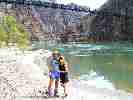
|
|---|
R & K and THE River
(Click the image for a full-size view)
|
|---|
|
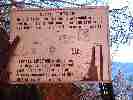
|
|---|
Namesake of this report
(Click the image for a full-size view)
|
|---|
|

|
|---|
Wall Street or Creek warning?
(Click the image for a full-size view)
|
|---|
|
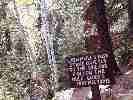
|
|---|
A message to republicans
(Click the image for a full-size view)
|
|---|
|
The adventure begins with Craig waiting patiently by the fax machine, doggedly attempting to obtain a permit to hike THE canyon. He succeeds! Then, many weeks later, at the end of the Subway Synergism hike,
(Click here to see the Subway Synergism report)
Craig and I make plans for Roaring the Redwall limestone of Roaring Springs Canyon, down the North Kaibab Trail to Cottonwood Camp, and eventually to THE Colorado River. Yow.
Finally, the trip begins when Kathleen and I travel down the over-propagated provo parade of I-15 to Parowan. Here, the group gathers together to enjoy Craig's hospitality and get some sleep before the real fun begins.
In the morning, we pause in the Kolob section of Zion NP for a dayhike to view the radiant redwall of the Kolob Fingers. Our destination is Double-Arch Alcove. It's a lovely hike through golden shimmering Aspen leaves and the saturated greens of Ponderosa Pines. Continuing on, we pause for Mexican food in Kanab, a must for any plateau traveler.
The next morning we launch off the North Rim amidst a swirl of crispy Fall air, noting that the N Rim soon closes to vehicles, leaving the deer, elk, turkeys, bears and other citizens of the Kaibab Forest in peace. The Aspens shriek their tremulous yellow, backed by a hint of distant Chinook Salmon cliff bands as we drop off into the steadily warming Roaring Springs Canyon. In the almost 5 miles to Roaring Springs, the trail looses about 2/3 of its 5850' of elevation to The river. Today, this plunge produces a pleasant warming introduction to the inner gorge of mindfulness and temperatures. This, North Kaibab, canyon entry is a jumbo jump compared to the relatively modest meander of the South Kaibab drop, from 7200' to 2400' = 4760'.
(Click here to see the North Kaibab Trail description on what is most certainly the best site about hiking the Grand Canyon.)
It is Bob Ribokas' "The Grand Canyon Explorer" site. On Bob's site, you will see a topo map and follow the N. Kaibab as it plunges off the North Rim, threading its way to the Colorado River.
(Click here to see the geology of the Grand Canyon - on Bob's site.)
There is simply no contest between the robust reports by Ribokas and the diminutive descriptions on the National Park Service site. Of course, if you wish to get the dirty about obtaining a rare permit, visit the NPS site.
At the Coconino Overlook, we enjoy our first ranging vista of The canyon. "Yowee!" we all exclaim. After our first gorp stop of the day, we continue down and down. The sound of rushing water wafts up from somewhere below. Puzzled, I search the far side of the canyon for the source of this incongruous, yet tranquil burble. It's Roaring Springs, shooting out of the cliff layers across the canyon, producing the riparian roar we now enjoy.
Soon, we pause at the pump care-takers' area for another well-deserved gorp stop. From here, the trail is more gentle, and we wind our way down to Cottonwood Camp for the evening, completing our 7-mile plummet into the canyon. An enchanting canyon rim silhouette develops as the sun fades (see photo above).
It's morning and we are strolling the dusky twilight across a Bright Angel Creek footbridge, looking for Ribbon Falls. Swinging around a canyon point, we feel a bit of mist then bump into the lower cone of the falls. "Wow, a double drop of delicate water ribbons," we reverently comment (photo above).
On and on we hike, down through eons of sandstone and limestone and shale layers, eventually the canyon closes and we enter the Box, arriving in the Vishu Schist that comprises this section of the inner gorge. Hiking past Cottonwood trees and the rustic relaxation of Phantom Ranch, and past the Bright Angel CG, we reach The Colorado River - a jade jewel of wilderness juggernauts wedged between the dark marbled swirls of Vishu Schist. Deluxe and delightful.
Kathleen writes: From base camp at Cottonwood, we set out. Gliding serenely down the trail along this Grand region we note the kaleidoscope of color through this rainbow of rock. Others streak on by, the Rim to Rimmers. Do they see? Anything? I'm wondering how someone could use the Grand Canyon as a track for their athletic training. Kind of sad. We don't change our pace and eventually the weathered wood of cabins begins to appear. The rustic cantina at Phantom Ranch is a welcoming sight after our 7+ mile trek. But we have another destination. John Wesley Powell called it The Great Unknown and here it is before our eyes - water - cleanses, restores, sustains, heals.
Sitting down we take off our boots and look out across the steelyblue grayness which invites us to cool our tired feet. And up to this point how have we known the Colorado River? As a respite from the heat of the trail, a playground for rafters, an oasis in the desert, a target for strife between states.
Who will claim it next? Today it is ours - Across one bank the Bighorn Sheep
graze patiently. Above us is the Kaibab Bridge which joins the 2 Trails - North and South, a fitting symbol at this moment marked with an engagement ring. Today, Rob and I join the 2 Trails of our lives. Two lovers start their journey together by this water -- water, where life begins. Kathleen.
Rob continues: We dip our toes in the silky emerald waters of this queen of the canyon system, enjoying its frigid refreshment, knowing that rapids rage downstream, upstream too. We spot a group of Bighorn Sheep browsing the far bank. Kathleen and I cross the Kaibab suspension bridge for a closer look. The ram is so busy with his lady friends that he manages only a perfunctory glance when my camera clicks. Lovely indeed. I wonder if these sheep would vote for continued use of motors on the Colorado? - the cacophony of overflights? doubting it before I finish the thought.
We backtrack to Phantom Ranch to write postcards, which will be carried out by mule, and languish under the big trees along Bright Angel Creek. "Ahh, time to irrigate and vegetate and contemplate," I comment. We pause inside the cantina to admire David's inner gorge t-shirts, only available at Phantom Ranch. Californina Babe Kathleen knows about figs and she notes that there's even a fig tree in this garden of Eden. Then, we begin the hike back up the canyon to Cottonwood Camp.
Cool dusky damp air settles on us as we course the crepuscular along Bright Angel Creek, noting the stately Century plants, the Agave, the delicate flowers of the prickly Cliffrose shrub, the buffoon unlikeliness of the tree-like Beaver Tail Cactus, the sweep of the towering canyon walls - reaching to touch the emerging stars. It is lovely. Albeit we are trail weary, we continue to revel in the aura of The canyon, reflecting on 14 miles of roving inner Earth. At camp, we rush to enjoy a frosty bath in the creek before sharing another delectable group dinner. Kathleen "oooohes" the canyon so deep you can see the stars at noon, and exclaims at its grandeur as the stars revolve into view over the rim, then back out of sight on the opposite wall.
Rising before the sun, we prepare to reluctantly hike out of the canyon. For Kathleen and me, it would be an extended day, because we are due in Smog Lake before tomorrow morning. Argh. Yet, now we are mindful of how this canyon envelopes us and how much we are enjoying the tug of backpack straps, the thudding of boots against ancient rock, the steady 'puff, puff' of the group traveling toward that high skyline known as the North Rim. We cook along in the morning coolness to where we cross Bright Angel Creek, and pause for gorp and a water refill at the caretaker's picnic grounds. "Irrigate, irrigate, for sunny times are ahead," notes Craig.
Now, the real climbing begins, as we are soon edging along the narrow trail, thinly sliced into the Redwall, plunging, soaring cliff walls below and above. We are suspended within the canyon. Climbing, climbing, we slip through the Supai Tunnel and arrive at the Coconino Overlook and pause for more gorp and a group photo (see the lead photo above).
Way before it is time, I pass the advisement to republicans "When mules pass stand quietly to the side and follow the mule guide's instructions." "It is time for folks who love the public lands to wake up from their doltish war drum fever and knee-jerk politics and see how (most) republicans have decimated our heritage and have us pay for it via corporate welfare, timber welfare, oil welfare, mining welfare...etc!" I utter in harmony with the sign. Then, I recall a quote by Tao te ching: "Who will prefer the jingle of jade pendants if he once heard stone growing in the cliff?" The Cree also have something to say about this: "Only after the last tree has been cut down, the last river has been poisoned, the last fish caught, will you find that money cannot be eaten," Cree Indian Prophecy
Golden, shimmering, trembling Populus Tremuloides (Quaking Aspens) glow in the low-angle light of a crispy Fall day near the rim, providing a brilliant contrast to the kelly green of pines and the distant blush of stately canyon walls. "Oh, I don't want to go," murmurs Kathleen with a voice reverently low so as to not interrupt the aura of it all. It makes perfect sense to me, for this is church, a canyon cathedral.
Yet, we enjoy the drive through a diversity of open parks and tracts of pines punctuated by bolts of blaze-orange aspens on the high plateau before dropping into Kanab and a yummy dinner at Escobars.
It's an early morning arrival for Kathleen and me in the city of smog and unbridled, reckless propagation (gee, imagine how those two things go together). We fall asleep dreaming of the whispering, sultry, sensual sweetness of camp alongside Bright Angel Creek, of the peaceful sounds of religiously roaring the Redwall of inner earth.
Jody writes: I have a favorite quote by John Muir. It reads; "Climb the mountains and get their good tidings. Nature's peace will flow into you as sunshine flows into trees. The winds will blow their own freshness into you, and the storms their energy, while cares will drop off like autumn leaves."
This quote does a good job describing the Grand Canyon experience for me. It was an opportunity to let nature heal me in one of the most spectacular natural settings anywhere. Hiking the Grand Canyon was more than just a strenuous hike in a beautiful canyon. It was a spiritual journey. A trip back in time billions of years as one descends into its depths. It was a healing trip, allowing me to give up the worries and strains of daily life and emerse myself in nature at its most splendid form. It was also about friendship and companionship. Sharing the experience with the group was one of the best parts of the trip.
Hiking the Grand was a release of sorts. As I reached the banks of the mighty Colorado and dipped my hands into the chilly water, it seemed to take away all my cares and worries. It left me with the sensational feeling or freedom and peace. In the canyon, one is given a new perspective through which to view their lives. As you look around you and realize that billions of years are represented in the walls surrounding you, it reminds you how short your time is on this Earth. It reminded me of what is truly important in life. It reminded me that I should live each and every day to its fullest. It reminded me how much I love life and I love nature.
The Grand Canyon is more than just grand. It is an experience beyond what words can describe. It is a spiritual journey into the depths of the Earth and the depths of one's soul. Jody
Redwall Limestone (notes from Bob Ribokas' site) - This layer averages about 335 million years old and is composed of marine limestones and dolomites. This is probably the most
prominent rock layer in the Canyon as it usually forms a sheer cliff ranging from
400-500 feet in height, which has become a natural barrier between the upper and
lower regions of the Canyon. The only way though this barrier is in areas where
the rock has faulted and broken apart to form a slope which can be climbed upon.
The deep reddish color of this layer is caused by iron oxides leaching out of the
layers above it and staining its outward face. Behind the reddish face the rock is a
dark brownish color. Numerous marine fossils can be found in the Redwall
Limestone including brachiopods, clams, snails, corals, fish and trilobites. Many
caves and arches can also be seen in the Redwall.
Other WV reports about the Grand Canyon:
Click here or on the Looking Lizard to go to all WV reports about The Grand Canyon
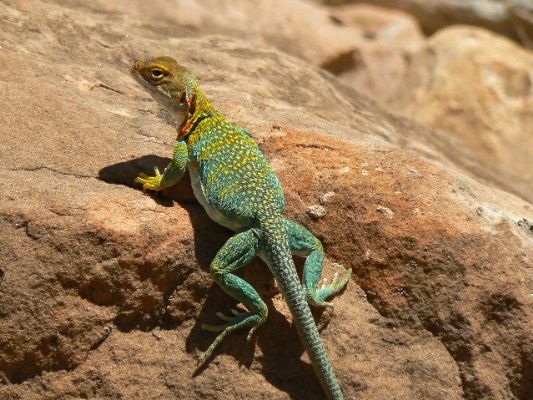
|
|---|
Looking for All Wilderness Vagabond trip reports about the Grand Canyon?
Click the image to go to All WV reports about The Grand Canyon
|
|---|
|
|
